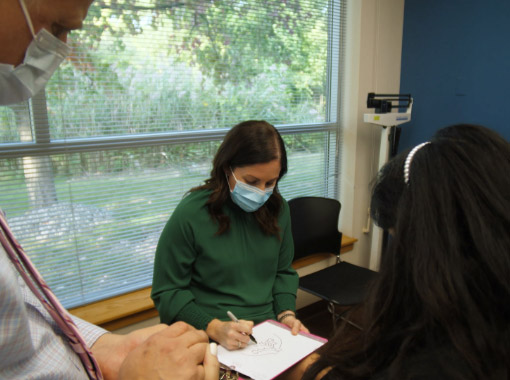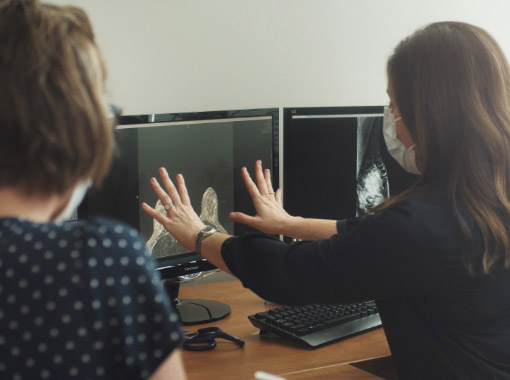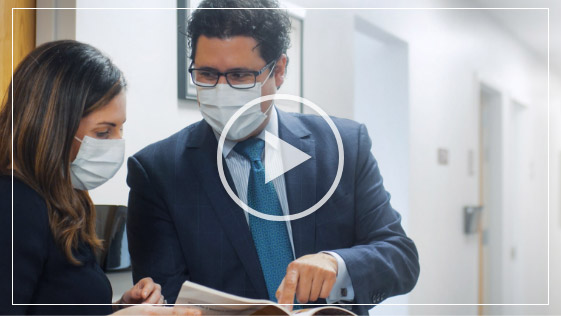Attentive Care & Consultation
Experienced With All Forms of Breast Cancer & Breast Cancer Risk Factors
Dr. Farkas is well-versed in treating all forms of breast cancer, including invasive ductal carcinoma (IDC), ductal carcinoma in situ (DCIS), and invasive lobular carcinoma (ILC). She also has experience treating patients with less common types of breast cancer, including inflammatory breast cancer, Paget’s disease, angiosarcoma, Phyllodes tumors, and patients with benign or premalignant conditions including fibroadenomas, atypical ductal hyperplasia, and radial scars.
Dr. Farkas also has extensive experience treating patients with strong family histories of breast or ovarian cancer, those with known mutations in the BRCA1 or the BRCA2 genes, or those with mutations in one of several other genes that are known to be associated with breast cancer, including but not limited to CHEK2, ATM, TP53, or PTEN.


My family and friends felt certain I was in the best possible hands and receiving optimum care. I was impressed with Dr. Farkas’s knowledge, skill, compassion, and transparency. — Abby

The Right Surgery for Your Needs

Heartfelt thanks for all that you have done to help me through such an emotionally traumatic time. I feel that I have been blessed to have such a gifted surgeon. What you do for breast cancer patients is amazing and I thank you for your dedication. — Teresa
Cancer Removal
Lumpectomy (partial mastectomy)
Used for treatment of breast cancer, lumpectomy allows a surgeon to remove the tumor and enough of the surrounding tissue to achieve resection margins that are free from cancer. Typically recommended to patients whose cancers are small and have been detected early, this operation can allow for tumor removal while allowing for most of the breast to remain intact. In cases where lumpectomy is done for breast cancer, radiation therapy is commonly recommended afterwards.
Mastectomy
Simple (or Total) Mastectomy
Cancer Prevention
Bilateral Risk-Reducing Mastectomy
Bilateral mastectomy is the operation of choice for a woman who is at increased risk of breast cancer. This procedure offers the greatest reduction of cancer risk because of the large amount of breast tissue removed. Bilateral prophylactic mastectomy has been shown to reduce the risk of breast cancer by at least 90% in women who carry a mutation in the BRCA1 gene or the BRCA2 gene and by 95% in those with a strong family history of breast cancer. We know that every woman has her own risk profile, and we welcome you to make an appointment to come in and discuss the right approach to your cancer risk.
Contralateral Risk-reducing Mastectomy
In situations where breast cancer is diagnosed in a patient who is at high risk for recurrence or for the development of a second primary cancer in the opposite breast, consideration is given both to the treatment of the known cancer and to risk reduction in the unaffected side. In this context, bilateral mastectomy is considered. This procedure aims to completely remove the breast tissue of both breasts, thereby treating the known cancer on one side and aiming to prevent new cancers on the opposite side. This approach also offers advantages for reconstructive options, as it maximizes the potential for symmetry in the reconstructed breasts.

What to Expect Before & After Surgery
During Your Consultation
You will meet with Dr. Farkas and her staff to discuss your diagnosis, the various treatment options that are most appropriate, and the optimal timing for surgery. Prior to surgery, you’ll review all the surgical options that are available and select the procedure which best suits your diagnosis, goals of treatment, and gives you the best possible result.
Financing Available Through:
Pre-Operation
One week before surgery you'll meet with Dr. Farkas’ staff for a pre-operative visit, where any last-minute questions can be answered and the logistics of your operation will be discussed. On the day of surgery, you will again have an opportunity to meet with Dr. Farkas. She will review your procedure with you and perform an examination to confirm that you’re in good health for your surgery. You may have paperwork to complete or be given prescriptions to fill; we may also take “before” photos, with your permission. As always, we will answer any questions and discuss any concerns so that you feel completely confident as your surgery approaches.
Final Preparation
One day before your surgery, confirm the arrangements for your procedure (including transportation) and to prepare your home for a relaxing and comfortable recovery. Shower with antibacterial soap, avoid eating or drinking after midnight, and be sure to follow any other specific instructions provided by Dr. Farkas and our staff. Please remember to avoid Aspirin, blood-thinning medications, vitamins, and other homeopathic medications unless specifically discussed.
Surgery
Please plan to arrive early to check in and prepare for your procedure. You should wear loose-fitting, comfortable clothes, and leave jewelry and valuables at home. You can expect to remain in the recovery room for several hours following completion of the surgery. When you get home, you may take the prescribed pain medication as needed. Limit your activity for at least the next 24 hours.
Recovery
We will schedule follow-up appointments as necessary throughout your recovery. Your post operative appointment will be scheduled with enough time to review surgical findings and pathology results. Dr. Farkas will assess your healing, remove or change dressings, advise you on activity limitations, and communicate your progress and results with your primary care doctor and any other treating physicians.
Long-Term Follow Up
Depending on the diagnosis, you may continue to follow up in our office with Dr. Farkas and her team.
These instructions will be provided at your postoperative visit.








 Hello, my name is Melanie Morreale. I attended art school in 1992, majoring in graphic art. Some of the things I loved were color theory, photography and illustration. I started my tattooing apprenticeship while in school and began working full time as an artistic tattoo artist right after college.
Hello, my name is Melanie Morreale. I attended art school in 1992, majoring in graphic art. Some of the things I loved were color theory, photography and illustration. I started my tattooing apprenticeship while in school and began working full time as an artistic tattoo artist right after college.